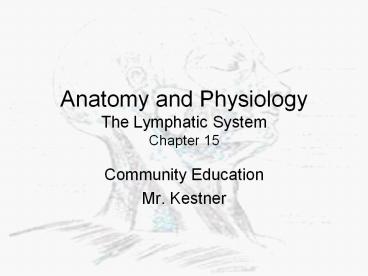Anatomy and Physiology The Lymphatic System Chapter 15 - PowerPoint PPT Presentation
1 / 18
Title:
Anatomy and Physiology The Lymphatic System Chapter 15
Description:
Anatomy and Physiology The Lymphatic System Chapter 15 Community Education Mr. Kestner Lymphatic System Consists of lymph, lymph vessels, lymph nodes, lymphatic ... – PowerPoint PPT presentation
Number of Views:1049
Avg rating:3.0/5.0
Title: Anatomy and Physiology The Lymphatic System Chapter 15
1
Anatomy and PhysiologyThe Lymphatic
SystemChapter 15
- Community Education
- Mr. Kestner
2
Lymphatic System
- Consists of lymph, lymph vessels, lymph nodes,
lymphatic tissue, and 4 organs - Tonsils
- Spleen
- Thymus Gland
- Peyers Patches
- Works in conjunction with the circulatory system
to remove wastes and excess fluids from the
tissues
3
Lymphatic System Functions
- Drain protein-containing fluid from tissue spaces
(primary function) - Interstitial fluid can cause edema
- Transport fats from the digestive system
- Via lacteals in the villi of the small intestine
- Produce lymphocytes
- A type of leukocyte
- Develop immunities
- antibodies
4
Lymph
- A thin, watery fluid composed of intercellular,
or interstitial fluid, which forms when plasma
diffuses into tissue spaces - Composed of water, digested nutrients, salts,
hormones, oxygen, carbon dioxide, lymphocytes,
and metabolic wastes such as urea - When this fluid enters the lymphatic system, it
is known as lymph
5
Lymphatic Vessels
- Located throughout body in almost all of the
tissues that have blood vessels - Small, open-ended lymph vessels act like
drainpipes and are called lymphatic capillaries - Lymphatic capillaries pick up lymph at tissues
throughout body - Capillaries then join together to form larger
lymphatic vessels, which pass through lymph nodes - Contractions of skeletal muscles against lymph
vessels cause the lymph to flow through the
vessels - Lymphatic vessels also have valves that keep
lymph flowing one-way - Drains lymph into blood via thoracic duct (main)
or right lymphatic duct
6
Lymph Nodes
- Popularly called glands
- Located all over body, usually in groups or
clusters - Small, round or oval masses ranging in size from
that of a pinhead to an almond - Filter lymph and remove impurities such as
carbon, cancer cells, pathogens, and dead blood
cells - Produce lymphocytes and antibodies
7
Lymphatic Tissues
- Tonsils masses of lymphatic tissue that filter
interstitial fluid there are 3 pairs - Palatine tonsils located on each side of the
soft palate - Pharyngeal tonsils (also called adenoids)
located in the nasopharynx - Lingual tonsils located on the back of the
tongue - TA not performed as often due to better
understanding of importance of these tissues
8
Lymphatic Tissues
- Spleen
- An organ located beneath the left side of the
diaphragm and in back of the upper part of the
stomach - Produces leukocytes and antibodies
- Destroys old erythrocytes
- Stores erythrocytes to release into bloodstream
if excessive bleeding occurs - Releases hemoglobin to be recycled
- Filters metabolites and wastes from body tissues
9
Lymphatic Tissues
- Thymus
- A mass of lymph tissue located in center of upper
chest - Atrophies after puberty and is replaced by fat
and connective tissue - During early life, it produces antibodies and
manufactures lymphocytes to fight infection - Its function is taken over by the lymph nodes
10
Lymphatic Tissues
- Peyers Patches
- AKA aggregated lymphatic follicles
- Found in wall of small intestine
- Resemble tonsils
- Macrophages destroy bacteria
- Prevents bacteria from infecting and penetrating
walls of the intestine
11
Lymphatic Tissue
12
Immunity
- Ability of body to resist infection from
pathogens - Active response from antigen or vaccination
- Passive via placenta, breast milk, or antivenom
- Antigens
- Foreign proteins that gain access to our bodies
via circulatory, digestive, respiratory, urinary
and reproductive systems - Cause immune system to produce high molecular
weight proteins called antibodies - Antibodies or Immunoglobulins
- Bind with specific antigens
- Binding causes agglutination
- Leukocytes eat agglutinate by phagocytosis
13
Diseases and Abnormal Conditions
- Adenitis
- Hodgkins Disease
- Lymphangitis
- Splenomegaly
- Tonsillitis
14
Adenitis
- Inflammation or infection of lymph nodes
- Occurs when large quantities of harmful
substances, such as pathogens or cancer cells,
enter the lymph nodes and infect the tissue - Symptoms include fever and swollen, painful nodes
- If infection is not treated, an abscess may form
in the node - Usually treatment methods are antibiotics and
warm, moist compresses - If an abscess forms, it is sometimes necessary to
incise and drain the node (I D)
15
Hodgkins Disease
- A chronic, malignant disease of the lymph nodes
- Most common form of lymphoma
- Symptoms
- Painless swelling of the lymph nodes, fever,
night sweats, weight loss, fatigue, and pruritus
(itching) - Chemotherapy and radiation are usually effective
forms of treatment
16
Lymphangitis
- An inflammation of the lymphatic vessels
- Usually resulting from an infection in an
extremity - Symptoms include a characteristic red streak
extending up an arm or leg from the source of
infection fever chills and tenderness or pain - Treatment methods include antibiotics rest
elevation of the affected part and/or warm,
moist compresses
17
Splenomegaly
- An enlargement of the spleen
- Can result from an abnormal accumulation of RBCs
mononucleosis and cirhosis of the liver - Main symptoms are swelling and abdominal pain
- Increased destruction of cells could lead to
- Anemia
- Leukopenia
- Thrombocytopenia
- If spleen ruptures, intraperitoneal hemorrhage
and shock can lead to death - In severe cases, a splenectomy is performed
18
Tonsillitis
- Inflammation or infection of the tonsils
- Usually involves the pharyngeal and palatine
tonsils - Symptoms include throat pain dysphagia fever
white or yellow spots of exudate on tonsils and
swollen lymph nodes near the mandible - Antibiotics, warm throat irrigations, rest, and
analgesics are the main forms of treatment - Chronic, frequent infections or hypertrophy that
causes obstruction are indications for
tonsillectomy






























